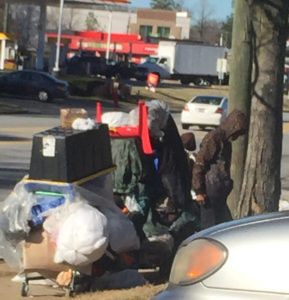 Today is much like the day in this photo. The sun shines brightly and fiercely. The sky wears its best blue. Winter grips us tightly enough, teasing those of us who live in the South with its power to turn into a deathly reality.
Today is much like the day in this photo. The sun shines brightly and fiercely. The sky wears its best blue. Winter grips us tightly enough, teasing those of us who live in the South with its power to turn into a deathly reality.
The difference in today and the day of this photo is that the person—I believe it was a female—is not in the picture. For several years, this homeless person switched her location between this spot near fast food restaurants and an all-night grocery store with one across the street that has a combo convenience store and service station nearby. I watched for her every time I joined hundreds of other drivers regularly and quickly traversing this intersection.
I absorbed that day’s scene as much as I could, give that frequently the traffic moved quickly. Occasionally, the red light caught me, and I was able to see more.
This woman created what seemed to be a well-functioning abode. Essential to her life, shopping carts formed the basis of whatever structure she built. They held most of her belongings. (This photo only shows the beginning of a much larger domain.) Running a close race for the essential essentials was plastics, which seemed to proliferate in the warmer weather. Plastic buckets, plastic drinking cups, plastic bottles, plastic lawn chairs, plastic tarps, plastic storage bins, plastic bags—all things plastic.
Finding plastic in our society is easy. But, I wondered how far and wide she roamed in her shopping. Then, I wondered—to my horror—if she ate, drank or otherwise used whatever had been left in the plastic containers.
Brooms, mops and industrial-size brushes featured prominently at her house. Why? What did she do with them? How much and what did she clean Or, did just having them provide some sort of security for her, as it does for so many “homed” people?
She had cardboard boxes. That I understand. Cardboard boxes, plastic tarps and a plastic chair, in the right combination, could provide shelter.
While the summer heat and humidity in the South are no laughing matter, winters here can sneak up and can turn deadly quickly. That’s when I worried about her. The cold seems unbearable. The only time I saw the person I think was this woman was during one of those unbearable cold spells. I was grocery shopping, and she had stepped just inside the store. She didn’t continue into the store as if there to shop; she just stood inside in the warmth. I wondered how often she did that and whether the store cared or even knew. Or perhaps they gave her warm food and drink?
I noticed other things that gave me a bit of hope. The first was that during an extremely cold spell, I saw she had built sort of an igloo shaped dwelling out of what else but grocery carts, plastic and cardboard. It seemed okay, maybe it keep her warm or at least from freezing to death. But I became worried when I passed several times and did not see her at all. Then, one day I saw a leg and a foot extended through the door opening.
On another winter’s day trip, I saw that she had on what looked like new, or almost new, sturdy boots. That’s when I entertained the idea that someone was helping her. Maybe she wasn’t totally alone in her life, several seasons of which she spent on two corners of a busy Metro Atlanta intersection.
But this year she is gone. Every time I pass her corners, I look for her and wonder. I wonder where she went and why. Did wonder lust call and she took off on foot, pulling and pushing her world with her? Or did she call a moving van to transport her? Was she made to leave by the merchants and/or the government? Worse still, did she become ill and die—alone?
I’ll never know. I pray she found shelter with people who care about her.
In the United States, almost 554,000 people experience homelessness on a given night: in Georgia, its more than 10,000. Myriad reasons caused people to become homeless. Those of us who have warm or cool homes, depending on the season, best not judge. It is easy to say, “Well homeless people should …,” followed by whatever we think their “failing” to be.
Our better selves should help in any way we can. For homeless people who want more permanent housing, we can help them find it.
We can also help with temporary housing. When the winter temperature falls to a certain point, my church parish provides a hotel room for families with children. That is a practical way to help. It doesn’t save the world, but it can save one family for one cold night. Those of us who have been temporarily cold know how good the warmth feels. We can provide or join others in providing that warmth through shelter, clothing, blankets and food. If we get really serious, we can do so much more.
I only observed the woman on the corner. I wish I had done something.
Leave a Reply